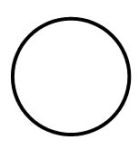Cultures and religions that use the circle and the wheel for spiritual evolution are many and varied. The circle is found in nature, art and buildings and the wheel of life is part of the sacred geometry through which we experience our physical existence, evolve and return to the source of consciousness. When we focus on the repeated patterns we are able to evolve to a greater awareness and consciousness.
The wheel is a made up of a circle connected by spokes which radiate from a central hub or smaller circle. A wheel must be balanced to turn effectively.The circle or wheel is sacred to many cultures and religions and symbolizes unity and movement. It represents protection and completion. The circle of life is part of sacred traditions all over the world.
In its simplest form the circle has no beginning or ending.
To live a life less scattered, we talk of centering ourselves. We do this by going within the circle or outer body and seeking to create a balance in all areas of our life.
The centre of the wheel is the hub, from which the spokes are constructed and this in turn is connected to an axle. Which is turn is connected to another wheel. Here we have contraction and expansion of the inner circle according to the purpose for which it is needed and connections between circles which we once thought solitary.
Thirty spokes share the wheel’s hub;
it is the centre hole that makes it useful.
Shape clay into a vessel;
It is the space within that makes it useful.
Lao Tzu
After finding the centre, a circle may also be divided into parts. This may be done by adding more circles within or without or by drawing straight lines across the circle.
A pebble drops…
Water ripples,
as do labyrinths…
Circle upon circle touching the shore of our soul,
moving us back and forth,
taking us home,
to the heart of being,
taking us, into life…
Lea Goode-Harris
Concentric circles are found in many primitive and pagan art and spiritual traditions as well as forming the basis for the Labyrinths that are found in many cultures. These include Ancient Greek and the Christian Labyrinths and crop circles.
Often different words or colours are placed within the circles as an aid to visualize spiritual concepts.
The most well known labyrinth is at Chartres Cathedral. It is a 12 ring pattern that twists and turns through 28 loops within the four quadrants and ends at a central space in the shape of a rose. Built in the Middle Ages, when pilgrimages were popular, the labyrinth allowed the pilgrim to go within and experience a spiritual journey.
Walking the labyrinth, even today, allows the pilgrim to find centeredness, a connection to the higher self, although some are challenged by the physical journey.
Once in the centre, there is time and space to meditate or pray. The journey outward then symbolizes the emergence of the transformed pilgrim.
Other labyrinth designs were simple, either a 5 or 7 circuits that are similar in shape to a brain and walking the labyrinth will exercise both sides of the brain.
Some people are physically challenged by the process. This may be due, in part to the role of the vestibular system, which interestingly has a labyrinth in the inner ear.
The vestibular system contributes to our spatial awareness and balance.
When walking the labyrinth several senses, such as the vestibulo-ocular reflex (VOR), the fluid within the semi-circular canals and the cilia (small hairs) in the otolithic organs are exercised.
Our perception is challenged by narrowing our focus to the circular path and we start to rely more on cues from other senses. Motion sickness may be experienced by some people when their vestibular system provides conflicting messages.



